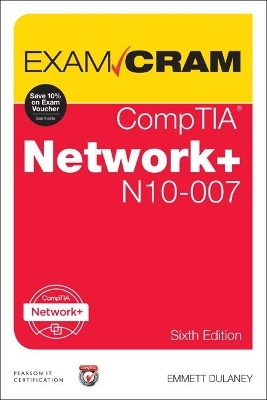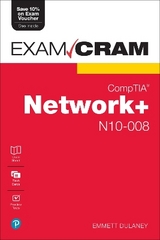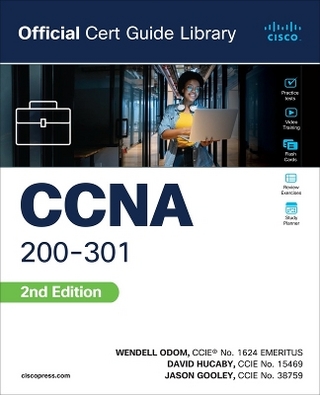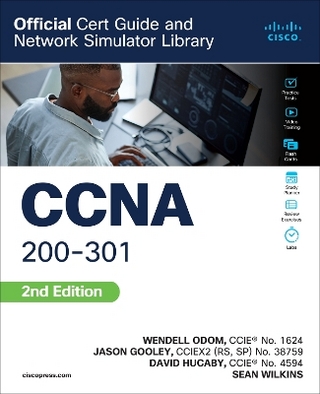
CompTIA Network+ N10-007 Exam Cram
Pearson IT Certification
978-0-7897-5875-0 (ISBN)
- Titel erscheint in neuer Auflage
- Artikel merken
CompTIA® Network+ N10- 007 Exam Cram, Sixth Edition is the perfect study guide to help you pass CompTIA’s Network+ N10-007 exam. It provides coverage and practice questions for every exam topic, including substantial new coverage of security, cloud networking, IPv6, and wireless technologies. The book presents you with an organized test-preparation routine through the use of proven series elements and techniques. Exam topic lists make referencing easy. Exam Alerts, Sidebars, and Notes interspersed throughout the text keep you focused on what you need to know. Cram Quizzes help you assess your knowledge, and the Cram Sheet tear card is the perfect last-minute review.
Covers the critical information you’ll need to know to score higher on your CompTIA Network+ (N10-007) exam!
· Understand modern network topologies, protocols, and infrastructure
· Implement networks based on specific requirements
· Install and configure DNS and DHCP
· Monitor and analyze network traffic
· Understand IPv6 and IPv4 addressing, routing, and switching
· Perform basic router/switch installation and configuration
· Explain network device functions in cloud environments
· Efficiently implement and troubleshoot WANs
· Install, configure, secure, and troubleshoot wireless networks
· Apply patches/updates, and support change/configuration management
· Describe unified communication technologies
· Segment and optimize networks
· Identify risks/threats, enforce policies and physical security, configure firewalls, and control access
· Understand essential network forensics concepts
· Troubleshoot routers, switches, wiring, connectivity, and security
Companion Website
The companion website contains the powerful Pearson Test Prep practice test software, complete with hundreds of exam-realistic questions. The assessment engine offers you a wealth of customization options and reporting features, laying out a complete assessment of your knowledge to help you focus your study where it is needed most. This online assessment engine enables you to access the practice tests via the Internet on any desktop, laptop, tablet, or smartphone device with Internet connectivity. The web-based version also enables you to download the software to your desktop, so you can use the practice test even when you don't have an Internet connection. The desktop version syncs with your online version when an Internet connection is established, to update and track your progress. This integrated learning package offers these additional benefits:
· Enables you to focus on individual topic areas or take complete, timed exams
· Presents unique sets of exam-realistic practice questions
· Tracks your performance and provides feedback on a module-by-module basis, laying out a complete assessment of your knowledge to help you focus your study where it is needed most
Pearson Test Prep online system requirements:
Browsers: Chrome version 40 and above; Firefox version 35 and above; Safari version 7; Internet Explorer 10, 11; Microsoft Edge; Opera.
Devices: Desktop and laptop computers, tablets running on Android and iOS, smartphones with a minimum screen size of 4.7". Internet access required.
Pearson Test Prep offline system requirements:
Windows 10, Windows 8.1, Windows 7; Microsoft .NET Framework 4.5 Client; Pentium-class 1 GHz processor (or equivalent); 512 MB RAM; 650 MB disk space plus 50 MB for each downloaded practice exam; access to the Internet to register and download exam databases
Emmett Dulaney (CompTIA Network+, Cloud+, Security+, A+, and others) is the author of numerous books on certifications and operating systems. He is a columnist for Certification Magazine and a professor at a small university. He is also the author of CompTIA A+ Complete Study Guide and CompTIA Security+ Study Guide.
Introduction
Chapter 1: Introduction to Networking Technologies
Wired and Wireless Network Topologies
Bus Topology
Ring Topology
Star Topology
Wired Mesh Topology
Wireless Topologies
Hybrid Topologies
Network Types
LANs
WLANs
WANs
MANs
CANs
SANs
PANs
IoT Technologies
Z-Wave
Ant+
Bluetooth
NFC
IR
RFID
802.11
The Magic Behind 802.11n and 802.11ac
A Summary of 802.11 Wireless Standards
What’s Next?
Chapter 2: Models, Ports, Protocols, and Networking Services
The OSI Networking Model
The OSI Seven-Layer Model
Comparing OSI to the Four-Layer TCP/IP Model
Identifying the OSI Layers at Which Various Network Components Operate
Ports and Protocols
Connection-Oriented Protocols Versus Connectionless Protocols
Internet Protocol
Transmission Control Protocol
User Datagram Protocol
File Transfer Protocol
Secure File Transfer Protocol
Trivial File Transfer Protocol
Simple Mail Transfer Protocol
Hypertext Transfer Protocol
Hypertext Transfer Protocol Secure
Post Office Protocol Version 3/Internet Message Access Protocol Version 4
Telnet
Secure Shell
Internet Control Message Protocol
Network Time Protocol
Lightweight Directory Access Protocol
H.323
Simple Network Management Protocol
Session Initiation Protocol
Remote Desktop Protocol
Server Message Block
Understanding Port Functions
ARP and RARP
Network Services
Domain Name Service (DNS)
The DNS Namespace
Types of DNS Entries
DNS Records
DNS in a Practical Implementation
Dynamic Host Configuration Protocol
The DHCP Process
DHCP and DNS Suffixes
DHCP Relays and IP Helpers
IP Address Management
Network Time Protocol
What’s Next?
Chapter 3: Addressing, Routing, and Switching
IP Addressing
IPv4
IP Address Classes
Subnet Mask Assignment
Subnetting
Identifying the Differences Between IPv4 Public and Private Networks
Classless Interdomain Routing
Default Gateways
Virtual IP
IPv4 Address Types
IPv6 Addressing
Comparing IPv4 and IPv6 Addressing
Assigning IP Addresses
Identifying MAC Addresses
NAT, PAT, SNAT, and DNAT
Managing TCP/IP Routing and Switching
The Default Gateway
Routing Tables
Static Routing
Switching Methods
Software-Defined Networking
Dynamic Routing
Network Traffic
Routing Metrics
Virtual Local-Area Networks
The Spanning Tree Protocol
Interface Configuration and Switch Management
Trunking
Port Mirroring
Port Authentication
Power over Ethernet
DMZ
MAC Address Table
Switch Management
Managed and Unmanaged
Quality of Service
Traffic Shaping
Access Control Lists
What’s Next?
Chapter 4: Network Components and Devices
Common Network Devices
Firewall
Router
Switch
Hub
Bridge
Modems
Wireless Access Point
Media Converter
Wireless Range Extender
VoIP Endpoint
Network Devices Summary
Advanced Networking Devices
Multilayer Switch
Wireless Controller
Load Balancer
IDS/IPS
Proxy Server
VPN Concentrator
AAA/RADIUS Server
UTM Appliances and NGFW/Layer 7 Firewalls
VoIP PBX and Gateway
Content Filter
What’s Next?
Chapter 5: WAN Technologies
WAN Technologies
Integrated Services Digital Network
Leased Lines
Fiber, SONET, and OCx Levels
Frame Relay
Asynchronous Transfer Mode
Copper Versus Fiber
Other WAN Technologies
Internet Access Technologies
DSL Internet Access
Cable Broadband
Broadband Security Considerations
Dial-up
The Public Switched Telephone Network
Satellite Internet Access
Wireless Internet Access
Termination Points
What’s Next?
Chapter 6: Cabling Solutions
General Media Considerations
Broadband Versus Baseband Transmissions
Simplex, Half-Duplex, and Full-Duplex Modes
Data Transmission Rates
Types of Network Media
Types of Media Connectors
Media Couplers/Converters
568A and 568B Wiring Standards
Straight-Through Versus Crossover Cables
Rollover and Loopback Cables
Components of Wiring Distribution
Ethernet Deployment Standards
Troubleshooting Common Wired Connectivity Issues
Attenuation
Latency
Jitter
Crosstalk
EMI
Open/Short
Incorrect Pin-Out
Incorrect Cable Types
Bad Port
Transceiver Mismatch
TX/RX Reversed
Duplex/Speed Mismatch
Damaged Cables
Bent Pins
Bottlenecks
VLAN Mismatch
Network Connection LED Status Indicators
What’s Next?
Chapter 7: Wireless Solutions
Understanding Wireless Basics
Wireless Channels and Frequencies
Cellular Access
Speed, Distance, and Bandwidth
Channel Bonding
MIMO/MU-MIMO/Unidirectional/Omnidirectional
Site Surveys
Establishing Communications Between Wireless Devices
Configuring the Wireless Connection
Troubleshooting Wireless Issues
Factors Affecting Wireless Signals
Troubleshooting AP Coverage
What’s Next?
Chapter 8: Cloud Computing and Virtualization
Cloud Concepts
Software as a Service
Platform as a Service
Infrastructure as a Service
Other Types of Services
Private Cloud
Public Cloud
Hybrid Cloud
Connectivity Methods
Security Implications and Considerations
The Relationship Between Resources
Virtualization and Storage-Area Networks
Virtualization
Storage-Area Networks
What’s Next?
Chapter 9: Network Operations
Documentation Management
Wiring and Port Locations
Physical and Logical Network Diagrams
Baselines
Policies, Procedures, Configurations, and Regulations
Labeling
Business Continuity and Disaster Recovery
Backups
Backup Best Practices
Using Uninterruptible Power Supplies
Alternatives to UPS
Hot, Warm, and Cold Sites
High Availability and Recovery Concepts
Monitoring Network Performance
Common Reasons to Monitor Networks
SNMP Monitors
Packet Sniffers
Throughput Testing
Port Scanners
Vulnerability Scanners
Network Performance, Load, and Stress Testing
Tracking Event Logs
Remote Access
Remote File Access
VPNs
Site-to-Site and Client-to-Site
HTTPS/Management URL
Out-of-Band Management
What’s Next?
Chapter 10: Network Security
Physical Security and Device Hardening
Adding Physical Security to the Mix
Two-Factor and Multifactor Authentication
Secured Versus Unsecured Protocols
Additional Device Hardening
Authentication and Access Controls
Mandatory Access Control
Discretionary Access Control
Rule-Based Access Control
Role-Based Access Control
RADIUS and TACACS+
Kerberos Authentication
Local Authentication
Lightweight Directory Access Protocol
Using Certificates
Auditing and Logging
Multifactor Authentication Factors
Access Control
Securing Wireless Networks
WPA, WPA2, TKIP-RC4, and CCMP-AES
Wireless Authentication and Authorization
Shared, Preshared, and Open Keys
Common Networking Attacks
Denial-of-Service and Distributed Denial-of-Service Attacks
Other Common Attacks
Vulnerabilities and Prevention
Mitigation Techniques
Signature Management
Device Hardening
Change Native VLAN
Switch and Port Protection
Demilitarized Zones (Perimeter Network)
VLAN Network Segmentation
Privileged User Account
File Integrity Monitoring
Role Separation
Using ACLs to Restrict Access
Honeypots and Honeynets
Penetration Testing
What’s Next?
Chapter 11: Network Troubleshooting
Troubleshooting Steps and Procedures
Identify the Problem
Establish a Theory of Probable Cause
Test the Theory to Determine Cause
Establish a Plan of Action
Implement the Solution or Escalate
Verify Full System Functionality
Document the Findings, Actions, and Outcomes
Hardware and Software Troubleshooting Tools
Wire Crimpers, Strippers, and Snips
Tone Generator and Probes
Loopback Adapter
Protocol Analyzer
Media/Cable Testers
TDR and OTDR
Multimeter
Spectrum Analyzer
Packet Sniffers
Port Scanner
Wi-Fi Analyzer
Bandwidth Speed Tester and Looking Glasses
Environmental Monitors
Command-Line Troubleshooting Tools
The Trace Route Utility (tracert/traceroute)
ping
ARP
The netstat Command
ipconfig
ifconfig
nslookup
dig
The tcpdump Command
The route Utility
nmap
Troubleshooting Common Network Service Issues
Common Problems to Be Aware Of
Hardware Failure
What’s Next?
Glossary
9780789758750 TOC 2/7/2018
| Erscheint lt. Verlag | 11.4.2018 |
|---|---|
| Reihe/Serie | Exam Cram |
| Verlagsort | Upper Saddle River |
| Sprache | englisch |
| Maße | 152 x 228 mm |
| Gewicht | 820 g |
| Themenwelt | Informatik ► Weitere Themen ► Zertifizierung |
| ISBN-10 | 0-7897-5875-X / 078975875X |
| ISBN-13 | 978-0-7897-5875-0 / 9780789758750 |
| Zustand | Neuware |
| Haben Sie eine Frage zum Produkt? |
aus dem Bereich



